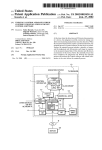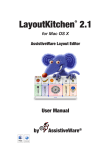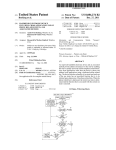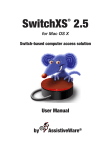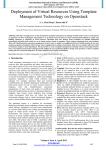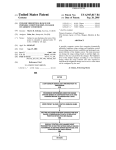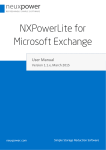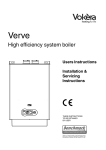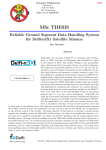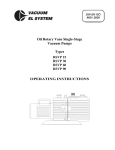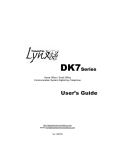Download Telephone dialler with easy access memory
Transcript
US006320957B1 (12) United States Patent (10) Patent N0.: (45) Date of Patent: Dragano?' (54) TELEPHONE DIALLER WITH EASY US 6,320,957 B1 Nov. 20, 2001 FOREIGN PATENT DOCUMENTS ACCESS MEMORY (75) Inventor: Georgi H. Dragano?', Mississauga 5 7004639A 63-80652 (CA) 11/1982 (JP) .............................. .. H04M/1/57 4/1988 (JP). OTHER PUBLICATIONS (73) Assignee: GEZ Microsystems, Inc., Toronto (CA) Motorola, cellular portable telephone user’s manual, 1990, (*) pp. 1—7. Notice: Subject to any disclaimer, the term of this patent is extended or adjusted under 35 (21) Appl. No.: 08/947,841 Primary Examiner—Wing F. Chan (74) Attorney, Agent, or Firm—Cook, Alex, McFarron, ManZo, Cummings & Mehler, Ltd. (22) Filed: (57) USC 154(b) by 0 days. Oct. 9, 1997 Related US. Application Data (63) Continuation of application No. 08/585,886, ?led on Jan. 16, 1996, now abandoned, which is a continuation of application No. 08/265,951, ?led on Jun. 27, 1994, now Pat. No. 5,541,988, which is a continuation-in-part of application No. 07/878,987, ?led on May 6, 1992, now Pat. No. 5,359,651. (30) Foreign Application Priority Data May 8, 1991 (CA) ................................................ .. 2042068 ABSTRACT An advanced telephone dialler has been described, incorpo rating a fast retrieval and dial telephone directory. The system simpli?es the use of the telephone directory by using a single sliding or rotary key for scanning and selection of the name and number to be dialled and one button for speed dialling of the selected number. The name and telephone number of the selected person are simultaneously displayed on a character display and a normal telephone keypad has been used for entering both letters for the name and digits for the number into telephone directory’s memory. A short cut dialling has been also provided by simply using the sequen (51) Int. Cl.7 .................................................... .. H04M 1/00 (52) US. Cl. ............. .. 379/354; 379/355.09; 379/357.04; tial order number of the person to be dialled from the 379/9323 telephone directory’s memory. An option has been provided for checking the incoming calls numbers with the telephone (58) Field of Search ............................. .. 379/354, 355.01, 379/355.02, 355.05, 355.09—356.01, 357.04, 93.18, 93.23, 100.14 directory of the system and not only displaying the name of the calling person and its number if they have been found in directory. In addition the telephone directory memory is (56) References Cited divided into pages each page having its own access code and the option to be locked or unlocked. If a selected page has U.S. PATENT DOCUMENTS been locked the access is denied unless a proper access code 4,117,542 4,278,845 4,304,968 9/1978 Klausner et al. .................. .. 364/900 7/1981 Chiou ................................. .. 379/355 12/1981 Klausner et al. .................... .. 379/69 4,440,977 4/1984 4,511,764 4,532,378 4/1985 Nakayama et al. 7/1985 Nakayama et al. P60 @161. ........... 4,661,976 4/1987 . . . .. 379/97 379/354 379/110 for this page has been entered. In the case of the calling number identi?cation feature, in addition to the name of the calling person if it is in the memory, the system displays the name of the person to whom the page, where this number Basch ................................. .. 379/354 resides, has been assigned. The application is targeted for heavy traf?c business or personal phones, family telephones, 4,800,582 1/1989 D’Agosto, III et al. .......... .. 379/216 cellular phones and as a part of an of?ce or home automation 4,825,464 4/1989 Wen system. 4,839,919 6/1989 Borges et al. ....................... .. 379/96 379/354 44 Claims, 7 Drawing Sheets (List continued on neXt page.) Hue Interface f-alepl'ane Interface Circuits Ulsplay US 6,320,957 B1 Page 2 US. PATENT DOCUMENTS 5,163,050 _ 4,924,496 4,982,423 5,067,150 5,359,651 11/1992 Cromack .............................. .. 379/88 * 10/1994 5/1990 Flga et a1. .......................... .. 379/355 1/1991 Muroi ........ .. .379/354 11/1991 Satomi et a1. ..................... .. 379/354 * cited by examiner Draganoff .......................... .. 379/355 U.S. Patent Nov. 20, 2001 Address Sheet 1 0f 7 2 M \ g 22 U Generator __")” US 6,320,957 B1 8 Telephone “5 g 5* % Line C) ‘‘ 5 interface \1 lg v 5% Telephone 11 E g Directory H 5 (--> <» Brill Telephone CPU lnterfaee <-—) Circuits > g E 4 \ /T—J e \3 l Character / no 6' 15 U.S. Patent / Nov. 20, 2001 9 / Sheet 2 0f 7 1o / US 6,320,957 B1 11 / POT ( 5 L‘ > __ 2 A/D Converter Shift Register gE %2 E 0 TControl Tcontrol lnata shift Address FIG.2 / 16 /1g 2 /l3 /11 / Shift 5L 5:? 1 Cap or Pot Variable (—___ _) Duty Generator Cycle_’ Timer _'> Register _+ 5;: __ 1'2 m \_/T—duty cycle ‘5 4 Cap or pot / T Clock TShift Address 13 /11 /2 Shift ; a - 14 / Variable (- _[ -)| Frequency Generator -_)r Timer _-)1 Register 1 5 g: \7-— l -=: H U Kr *1 T Clock are 4 Tshirt Control Address Data U.S. Patent Nov. 20, 2001 1 Sheet 4 0f 7 US 6,320,957 B1 Z \ \ i, H w 1 FlG.8 \ 4 start \ t 2 enter page \ access code incorrect entry _ >than Btimes? Y 7 select the page \ with page selector i 5 error message device is page locked flag yes block further entry for 30‘ \ yes I l enable inside page address selector 10 EXIT / U.S. Patent Nov. 20, 2001 US 6,320,957 B1 Sheet 5 0f 7 Start yes enter new is master code master code correct? no /5 dis P la Y an enter current master code * 5 error message incorrect entry repeated more th 12 8 times ? / enter the new "page access code" block further entry of the master code for 30 minutes 13 erase the content of the current page enter the new alphanumeric page identifier 15 exit FIG.9 / U.S. Patent Nov. 20, 2001 Sheet 6 0f 7 US 6,320,957 B1 1 6 start \ 2 . drsplay the name \ load incoming of the caller and the alphanumeric call number ldentlfler 0f the into a buffer corresponding page 3\ Yl compare the buffer with all numbers stored in telephone directory memory I 5 \ display the —) calling telephone number 0H1)’ i \ Y eXit U.S. Patent Nov. 20, 2001 Sheet 7 0f 7 US 6,320,957 B1 page selector device activated? page selector activated9 a / display phone number and name pointed by inside page selector switch to memory switch to next page dial mode inside page address selector activated? display page number and alphanumeric identifier L yes page selector activated? numerical key of the keypad activated? US 6,320,957 B1 1 2 The telephone dialler according to the invention provides TELEPHONE DIALLER WITH EASY ACCESS MEMORY an easy and fast access to the stored telephone directory through repositioning of a single sliding or rotary control, This application is a continuation of US. application Ser. No. 08/585,886, ?led on Jan. 16, 1996 abandoned Which is a continuation of application Ser. No. 08/265,951 ?led on Jun. 27, 1994 (now US. Pat. No. 5,541,988), Which is a Which depending on its position causes the associated address generator to generate an address, used to retrieve the necessary telephone number and associated With it addi tional information. Moving this control permits easy scan continuation-in-part of application Ser. No. 07/878,987, ?led May 6, 1992 (now US. Pat. No. 5,359,651). 10 ning of the contents of the telephone directory memory and by displaying it on an alpha-numeric display easy location of the desired number. The depressing of another button per forms the autodialling of the selected this Way number. In addition to the dialled number, additional alpha 15 displayed on the display thus permitting easy veri?cation. A standard telephone dialler keypad is used for entering BACKGROUND OF THE INVENTION There are many different telephone sets With autodialling numeric information, like the name of the called person is and stored telephone directory. They normally have some kind of memory for storing preselected and frequently called telephone numbers and usually every one of those numbers has a corresponding push-button. This kind of arrangement is very inconvenient if a large number of telephone numbers is stored as far as a separate push-button is required for each number. Also, additional information such as name and/or address can not be conveniently associated With push buttons. To assist in identifying the telephone numbers that are stored in the respective memory location, paper tabs, or inserts are juxtaposed the respective keys, and it is expected that the user Will Write onto each paper tab the name of the the numbers and as Well as the letters, but the keypad is alloWed to enter alphabetic characters only during “name” programming mode and behaves in all other modes as a standard telephone dialling keypad. 20 25 individual Whose telephone number is stored in the associ ated memory locations. a portable note book having a plurality of bound pages, frequently used, and the caller knoWs their position numbers in telephone memory. The keypad permits in “name” programming mode (the 30 Which can be opened to expose a desired page, each page having a plurality of Writing areas in the same relative positions Where alpha-numeric information can be entered; and an electronic unit comprising a receiving surface on Which said note book can be placed, a plurality of actuators means that just dialling the sequential number of the person to be called as it is stored in the telephone directory memory is enough. This feature is very useful for numbers, Which are mode When the additional alphanumeric information is It has been proposed in Can. Pat. 1,266,930 (pg. 1, ln. 24 . . . ):“ . . . a hybrid alphanumeric directory comprising In addition to the scanning mode, “shortcut” and “manual” modes are also available. The “shortcut” dialling 35 entered into telephone memory) to enter a full set of ASCII characters by multiple depressings of a button. For example for entering the letter “B” the button “2” on the keypad should be depressed 3 times in a roW and then depressing the button “enter” Will cause the ASCII code corresponding to this letter to be stored in memory. This Way the need for an alpha-numeric keyboard With all its complexity and cost is associated With said respective relative positions When said avoided. note book is placed on the receiving surface . . . means, for The ready availability of the additional alpha-numeric information in telephone memory is not only indispensable in medium to large autodialling directories, for identi?cation indicating Which page is exposed and means responsive to an output from said indicating means to associate said actuator With the respective data associated With the Writing areas of the exposed page.” This Way the number of actua tors (push-buttons) has been reduced, but there is additional operation to ?nd the right page and also there is no feedback to shoW that the selected number is the desired one. 40 and veri?cation purposes during dialling, but it also ensures such advanced features as “Who is calling” information (service provided by some North American companies), if 45 In some telephones With autodialling memory the number keep track for all incoming calls. The telephone directory is organiZed in pages; for example 9 pages, each containing 16 telephone number is displayed on alpha-numeric display during its entry into memory and also during dialling, so it could be veri?ed. Even it has been proposed in US. Pat. No. 4,341,929 to display in addition to a numerical telephone number, alpha betic characters representing the name of the individual associated With that telephone number. entries With corresponding names. In order to make the telephone directory to serve different people, for example different members of a family, each Thus both the name and the telephone number are stored and displayed. HoWever, in this proposal, a separate alpha numeric character keyboard is provided for the purpose of entering signals representing names. the telephone number of the caller exist in the directory not only the number is displayed but also the name of the caller, this last in combination With an ansWering machine could page can be locked by its oWn access code. This Will alloW 55 each member of the family, as in the example, to have his/her oWn directory not accessible by the others. At the same time some of the pages, Which are not locked by an telephone system for improved human interface and better “access code” are available for scanning by everyone and When the page change button sWitches to this page the display Will shoW the numbers and names contained in this page. If the page change button sWitches to a page Which has been locked by an access code the display Will display the access, retrieval and use of the data stored in this directory. name of the “oWner” of the page and request an access code SUMMARY OF THE INVENTION The subject matter of the present invention relates gen erally to advanced use of the telephone directory in a 60 At the same time the organiZation of the telephone directory entry for this page. This Will make it possible to have a into pages With the option of individual access to each page, common telephone serving several people and having an open and several personaliZed telephone directories With a telephone directory memory organiZed in pages, during “programming” mode the dialler ?rst prompts to alloWs for better utiliZation of the telephone directory and creation of a number of personaliZed subdirectories With individual access. 65 US 6,320,957 B1 3 4 enter the identi?er of the page, Where the telephone number to be programmed, Will reside. The identi?er could be either the sequential number of the page, or the additional alpha numeric page identi?er. If the page has been locked, the folloWing it timer circuitry. The input controls change the generator duty cycle and the timer measures it and then transfers the result to a shift register for normaliZation and ?nally to a temporary buffer (note again, the shift register and the temporary buffer could be implemented by dialler Will neXt issue a prompt to enter the proper access code for this page. There is also a code Word called “master code” for the purposes to make the directory controllable, as in cases When the “page access code” has been lost or forgotten, or When it has to be changed. In this case, hoWever When the softWare). On FIG. 4 is shoWn yet another embodiment of the Address Generator based on a variable frequency generator 10 master code is used to open a page its contents is erased automatically before its been open. This Way the privacy of temporary buffer could be accomplished by softWare). the oWner of the page Will be protected. The “master code” is available to the prime oWner of the telephone and is entered during the initial setup of the dialler. If “calling party number” service is available, the tele phone number of the incoming call is checked for match With the numbers in telephone directory memory for all pages, open or locked, and if such is found either only the 15 name of the caller, or the name of the “oWner of the page” or both are shoWn on the alphanumeric display. This Will FIG. 5 shoWs the layout picture of the telephone system keypad, connected to the CPU and respectively the character display connected also to the CPU and displaying the result of three consequent depressings of the button “1” on the keypad. The consecutive characters are shoWn overlapped but actually at ?rst depressing of “1” button an “1” Will be displayed, at second depressing it Will be replaced by “Q”, at third—by “Z” and then the process Will repeat until the button “enter” has been depressed, Which Will cause the current displayed character to be stored and the display provide information not only in regard Who is calling but also to Whom this call could relate. If the display permits also the calling party telephone number Will be displayed. By sWitching from page to page With the page selector device Without moving the inside page address selector the dialler Will display on the alphanumeric display the infor mation related to the currently selected page, like page and folloWing it timer. The input controls vary the genera tor’s frequency, Which is then measured by the timer, normaliZed afterWards by a shift register and ?nally stored into a temporary buffer (again the shift register and the cursor to move to the neXt position. The above sequence Will 25 be valid during entering the “name” information into the telephone directory memory. During normal dialling, short cut dialling or entering the telephone number into directory the keypad behaves as a standard telephone keypad. sequential number and the additional alphanumeric page FIG. 6 shoWs an eXample of a structure of the temporary identi?er. Any movement of the inside page address selector device, hoWever, Will cause the dialler to start displaying on buffer betWeen the telephone directory and the CPU. As it the alphanumeric display the telephone number and “name” currently pointed by the inside page address selector device “length” of the telephone number and the telephone number itself—in Binary Coded Decimal (BCD) code. This is done Within the selected page. The application of this telephone system is also very could be seen the “name” is stored in ASCII code and the 35 convenient for use in such of?ce automation and home automation equipment as fax machines etc. cells of the telephone directory. EMBODIMENTS OF THE INVENTION FIG. 7 shoWs an eXample of organiZation of the telephone directory. As it could be seen from this eXample the separate The embodiment of a telephone dialler according to the present invention includes a CPU Which controls all tele cells containing the name, telephone number and the length of the telephone number have equal length and should be in phone system periphery and performs all algorithms to implement the system, a nonvolatile memory for storing the telephone directory (could be EEPROM, Flash ROM, bat in order to save memory space. The number, sequence and contents of the blocks comprising the temporary buffer could be different depending on speci?c requirements to the system but should match the number and contents of the correspondence to the structure of the temporary buffer. This 45 tery backed up RAM or any other in circuit programmable memory) and permitting easy modi?cation of the data, a standard telephone like keypad (With small modi?cations explained later and made in order to accommodate the input of some additional characters), data character display (LCD Will make easier for the softWare to move the traf?c both Ways. FIG. 8 shoWs an implementation for the page select and inside page address select controls. FIG. 9 shoWs a ?oWchart describing the algorithm for entering of the master code, for opening or locking of a given page, and ?nally for entering of a neW page access code, as Well as the additional alphanumeric page identi?er. The page select algorithm is shoWn on FIG. 10, and the or any other similar) for displaying the contents of the telephone directory and means for scanning the contents of the telephone directory on the display and direct dialling using the data displayed on the display. algorithm for displaying the name of the person to Whom a BRIEF DESCRIPTION OF THE DRAWINGS 55 The block diagram of the Whole system has been soWn on FIG. 1, forming one embodiment of the invention. On FIG. 2 is shoWn an embodiment of the Address Generator of the telephone system, based on a potentiometer connected to one of the inputs of an A to D converter. The outputs of the A to D converter are connected to the parallel DETAILED DESCRIPTION OF THE DRAWINGS inputs of a shift register performing normaliZation of the result and outputting it to a temporary buffer (note, the shift register and the buffer could be implemented by softWare). On FIG. 3 there is another embodiment of the Address Generator, based on a variable duty cycle generator and page has been assigned in the case of the calling party number display mode is shoWn on FIG. 11. FIG. 12 is a ?oWchart of the algorithm for sWitching from manual mode of dialling to memory mode of dialling, as Well as the opposite—from memory dialling to manual. 65 As shoWn on FIG. 1 the telephone system according to the present invention includes an address generator 1 connected to a buffer 2 on one side and receiving control signals from the CPU 3 on the other. The buffer 2 on its side is connected also to the CPU 3 The telephone directory RAM 5, Which US 6,320,957 B1 5 6 could be either a non volatile RAM, EEPROM or any other 16 cells, the data inside the shift register 11 Will be shifted four bits to the right. After that from the outputs of the shift register 11 data is moved to the buffer 2 and is used further by the CPU 3 for generation of an effective address, adding it to the offset address of the telephone directory RAM 5, the kind of non volatile memory permitting segment erasure and on line programmability, is connected With its I/O data bus to a temporary buffer 4 and receives control and address data from the CPU 3, Which on its side is connected to a standard telephone like keypad 6, an alpha-numeric display 15 of CPU accesses a cell in the telephone directory RAM 5 Which suitable siZe and type and to telephone interface circuits 7, such as tone dialler, ring detector, call progress detector, a standard telephone handset circuit plus the handset itself, a speakerphone circuit etc. The telephone interface circuits 7 directly corresponds to a given position of the slider of the potentiometer 9, so, this Way moving the slider causes the 10 digit stored in buffer 2 to change in such a Way that all addresses in telephone directory RAM 5 are scanned and a on their side are connected to a suitable telephone line ?xed given position of the potentiometer 9 corresponds interface 8 such as telephone transformer and relay etc. The system functions as folloWs: the address generator 1, 15 alWays to a ?xed cell inside telephone directory RAM 5. Different embodiment of the address generator 1 is shoWn on FIG. 3. There a ?xed frequency variable duty cycle generator 12 is controlled either by potentiometer or variable Which could have different embodiments explained later, but in all cases is controlled by a single sliding or rotary type control, generates depending on the position of the control capacitor 16, Which varies the duty cycle of the signal fed an address or part of an address (could be simply the from its output to the input of a timer 13 measuring the Width sequential order of a cell from telephone directory), Which of the signal and loading the result to the parallel inputs of is stored in the buffer 2; after depressing the button “tel.” on the keypad 6, the CPU 3 takes the address from the buffer the shift register 11. The next steps are identical to that from FIG. 2. With a suitable choice of the duty cycle range and the 2, reads the corresponding cell from the telephone directory 5, Which contains the telephone number and other identify ing alpha-numeric data, moves this data into the temporary frequency of the generator 12 and accordingly the resolution of the timer 13, this embodiment of the address generator 1 Will meet any requirements regarding the siZe of the tele phone directory RAM 5. buffer 4 and then displays it in suitable form on the alpha numeric display 15. This process is continuous but discrete in time, so moving or rotating the control of the address generator 1 modi?es the address in buffer 2 and in discrete suitably chosen moments of time the CPU 3 takes this address reads the corresponding cell of the telephone direc tory 5, moves the data to the temporary buffer 4 and display 25 Third variation of the address generator 1 is shoWn on FIG. 4. Here the main difference from FIG. 3 is that the position of the controls 13 control a variable frequency generator 14 and the timer 13 is in period (frequency) mode of measurement. Here too by properly choosing the fre quency range of the generator 14 and the resolution of the timer 13, a Wide range of telephone RAM 5 could be reliably accessed. FIG. 5 shoWs some particularities of the keypad 6 and the Way the data is interpreted by the CPU 3 and displayed on 15. This Way just by moving the sliding or rotary control of the address generator 1 one could easily, fast and conve niently scan the contents of the telephone directory 5 on the display 15 keeping at the same time the currently displayed information into the buffer 4. If one presses in the mean time 35 the alpha-numeric display 15 during “name” programming the button “tel.” on the keypad 6 the displayed number is mode, eliminating this Way the need for an alpha-numeric outputted by the CPU 3, from the buffer 4 to the telephone interface circuit 7 and from there through the telephone line interface 8 to the telephone exchange. A variation of the above described Way for scanning of the telephone directory person, after ?rst depressing of a given push button the keypad 6 output is interpreted by the CPU 3 as the digit memory 5 is performed folloWing Way—after depressing the numeric display 15, second depressing of the same button is appropriate control button the keypad 6 is sWitched into “name” mode, described in the next pages, but only for the push button belloW the digit and accordingly replaces the ?rst entered alpha-numeric character, and after that by activating the sliding/rotary control of the address generator 1 only those numbers from the telephone directory memory keyboard. When in program mode to enter the name of the marked on it, and it is displayed same Way on the alpha interpreted by the CPU 3 as the ?rst character marked on the 45 digit on the display 15 and its ASCII code is stored into buffer 4; third depressing is interpreted as the second char acter belloW the digit and next depressings of the same 5 are displayed on display 15 and moved to the buffer 4 for button are interpreted as next marked characters and after Which the alpha-numeric supplementary data starts With the selected letter. In case of an incoming call (if the option is available) the system sends a request through the telephone interface circuits 7 and receives the calling party number Which is stored in buffer 4 and then compared to the the last again the digit is displayed and so on until the “enter” button on the keypad 6 is depressed Which leaves last character into buffer 4 and moves to next position for entering next character of the name till the depressing of the “end” button, the maximum alloWed number of characters has been exceeded, or the button “cancel” has been depressed. In ?rst tWo cases the mode automatically telephone numbers contained inside the telephone directory RAM 5 and if a match is found all the additional information is concatenated to the number data inside the buffer 4 and 55 displayed on to display 15. One possible embodiment of the address generator 1 is shoWn on FIG. 2. The variable voltage from the slider of the potentiometer 9 is fed to one of the inputs of the A to D sWitches to entering the telephone number and already the keypad 6 is interpreted by the CPU 3 as a normal only digital keypad. Only the digits corresponding to the depressed buttons are displayed on the display 15 and accordingly their codes stored in buffer 4. In the third case the buffer 4 and the display 15 are cleared and the Whole procedure starts from converter 10 With a suitable resolution and accuracy. The transformed into digital code value of this voltage from the outputs of the Ato D converter 10 is supplied to the parallel the very beginning. The entering of the telephone number is inputs of the shift register 11, Where a logical shift right is keypad 6 or exceeding the alloWed length for the telephone executed under control of the CPU 3, depending on the Ato D converter resolution 10 and the siZe of the telephone directory RAM 5. As an example if the A to D converter 10 has 8-bits resolution and the telephone directory RAM 5 has complete either after depressing the “end” button on the part of the buffer 4. In both cases the “length” is automati 65 cally stored in the appropriate location in buffer 4. Next procedure is to depress the button “store” on the keypad 6 and the contents of the buffer 4 is automatically stored by the US 6,320,957 B1 7 8 CPU to a cell in the telephone directory RAM 5, currently pointed by the address contained in the buffer 2. The only difference from the standard keypad is the addition in the neW keypad 6 of letters “Q” and “Z” belloW number “1” address selector 9 is enabled and the system exits 10 the page selection algorithm. If the page is locked 3, system requests the entry of the page access code 4 for this page. The system then checks for incorrect entry 6, if this is the and—“.” and space “SP” belloW “0”, Which Was necessary case the process is repeated, either until a correct entry, or to make them also available for programming. The structure of the buffer 4 is explained on FIG. 6. It should be noted that the “name” information is in ASCII code and the “length” of the telephone number and the telephone number itself in BCD in order to save memory space, but they could be of any other suitable type. FIG. 7 shoWs the internal structure of the telephone the number of entries exceeds eight 5, as in this case. In the last case the system blocks further entry of the page access code 8 for this page, for a predetermined amount of time (30 minutes in this example). If the entered page access code 6 is correct the system enables the inside page address selector 10 bytes; N—length of the telephone number in bytes. So, the 9 and exits the execution of the algorithm 10. FIG. 11 shoWs the ?oWchart for the calling party number algorithm. The incoming call number is loaded into a temporary buffer 2 and then compared by the means of the CPU With all numbers stored in the telephone directory memory 3, the CPU checks if a match is found 4. If there is no match, only the telephone number of the caller 5 is address increments from cell to cell by M+N+1 bytes. The displayed on the alphanumeric display. If, hoWever, there is structure of a roW in telephone directory RAM 5 corre a match, the system Will display the name of the caller and the alphanumeric identi?er of the page 6, Where this number directory RAM 5. RoWs are cells and as is shoWn the n-th address is displaced from the ?rst by (n—1)*(M+N+1) bytes, Where n—is the cell number, M—length of the “name” in sponds exactly to the structure of the buffer 4. One embodiment of the combination of page selector and inside page address selector devices is shoWn on FIG. 8. By initial depression on the slider/push button control 1 the telephone directory memory is selected and page one (in other implementation—last selected page) contents can be scanned by sliding the control 1. Further depressions on the control 1 Will sWitch consecutively to next pages. A ?oWchart for initial setup, for change, and ?nally for 15 resides. This is a very convenient feature to identify not only Who is calling, but also for Whom is this call. The displayed information depends on the capabilities of the alphanumeric display, in one case it could be the name of the caller, the “name” of the person to take the call, the sequential number 25 of the page and the calling party telephone number, but depending on the siZe of the display, only part of this information could be displayed, or displayed sequentially after depressings of a dedicated button for example. regular use of the master code is shoWn on FIG. 9. At the FIG. 12 describes a convenient Way to sWitch betWeen very beginning When the request for master code has been issued either by depressing dedicated button or combination of buttons the CPU checks if it is initial setup 2, if it is an manual dialling mode 1, and memory dialling mode 3. Let assume the dialler is in a manual dialling mode 1, Where a telephone number is dialled manually by sequential depress initial setup, a request to enter neW master code 3 is issued ings of numerical keys of the keypad. System checks con by the system. After the neW master code has been entered the system exits from master code entry mode of operation. On the second hand, if it is not an initial setup 2, there is another branch, asking if it is to enter a neW master code 4, if the ansWer is yes, the system requests the entry of the current master code 5. If the entered code is incorrect the tinuously if the page selector device has been activated, if it is not the dialler stays in manual dial mode 1. If the page selector 2 has been activated, the system sWitches the dialler to memory dial mode 3, it checks further if the inside page address selector has been activated 5, if it is not it displays on the alphanumeric display the selected page sequential number and the additional alphanumeric identi?er for this page 8, in another embodiment not shoWn in FIG. 12 the system Will display page one sequential number and its alphanumeric identi?er. It Will stay this Way checking if a numerical key of the keypad has been activated 9, if it is the 35 process repeats either until a correct master code has been entered, folloWed by the entry of the neW master code 3 and exiting master code mode 18, or if the incorrect entry is repeated more than certain number of times 10, eight in this case, further entry of the master code is blocked for a certain amount of time 14, thirty minutes in this case, and the CPU exits from the execution of the algorithm 18. In case that the 45 ansWer to the request for neW master code 4 is no, the system asks again to enter the current master code 7. It checks if the selector device is activated 10 to sWitch to another page, if it is it Will sWitch to another page 11, then check if the inside page address selector is active 5, display the neW page entered master code is correct 9, if it is incorrect the action sequential number and alphanumeric identi?er 8 and cycle of the system is the same as in the case of the entry of neW master code. If the entered master code is correct the system this Way. If the page selector has not been activated 10, the system Will directly go to check if the inside page address sWitches to the branch of the algorithm dealing With the parameters of the currently selected page. First thing the system does is to erase the content of the current page 11, thus privacy of the “oWner” of the page is assured. Next choice is to keep the page locked With a neW page access code or to open it. If the choice is to unlock it, the system resets the special page locked ?ag 16, asks to enter neW alphanumeric page identi?er 13 and exits 18. If hoWever, the request is to keep the system locked, page locked ?ag is set 17, the system requests the entry of a neW page access code 12, then the entry of the additional alphanumeric page identi?er for this page 13, and exits 18 the algorithm. The algorithm for page selection is described by the dialler Will sWitch back to manual dial mode 1, if there is no numerical key activated 9, the system Will check if the page 55 selector 5 is active and stay cycling inside the branch, until the inside page address selector has been activated 5, the system checks again if a numerical key on the keypad has been activated 6, and if so sWitches to manual dial mode 1, if not it starts displaying the telephone number indicia pointed by the inside page address selector device 7. While, the above described embodiments of the invention are the preferred ones, it is apparent to those skilled in the art that many other changes and modi?cations may be made Without departing from the invention in its broader aspects. Therefore the intention of the claims is to cover such changes and modi?cations falling Within the true spirit and ?oWchart on FIG. 10. The page is selected by means of the 65 scope of the invention. The embodiments of the invention in Which an exclusive property or privilege is claimed are de?ned as folloWs: the page has been locked 3. If it is open the inside page page selector device 2, ?rst thing the system checks for is if US 6,320,957 B1 10 1. A telephone dialler comprising: operating a manually operable address selection device permits scrolling through and vieWing stored contents of a designated memory page. a keypad to generate sequences of indicia corresponding to telephone numbers, 6. The method of claim 5 further including sWitching to a selected one of said memory pages by operating a page selection device. 7. The method of claim 3 Wherein said method further includes selecting among a plurality of discrete memory pages. an electronic alpha-numeric display device to present a display corresponding to a selected one of said sequences of indicia, a memory to store electronically said sequences of indicia and to provide a telephone directory, a central processing unit (CPU) coupled to said memory, 8. A telephone dialler comprising: said electronic display device, and said keypad, a keypad to generate a sequence of indicia corresponding to a telephone number; a page selection device; an address generator including a manually operable address selection device to permit a user to scroll through said stored sequences of indicia by selecting at least partial addresses for selectable ones of said stored sequences of indicia, said address generator being a memory to store said sequences of indicia to provide a 15 coupled to said CPU so that said at least partial addresses are communicated thereto, Wherein said CPU is connected to receive said addresses, access said memory, and obtain stored sequences of indicia in response to manual operation of said address selection device, and to cause said electronic display device to present a display corresponding to ones of of Which may be selected for retrieval from said memory by use of said page selection device; an electronic display device to display sequences retrieved from said directory; a manually operable scanning control device to control the scanning of indica of said selected page on said electronic display device; said stored sequences selected as a result of and cor responding to an amount of said manual operation so that a user can observe on said electronic display device 25 the scrolling through data stored Within said telephone ing at least one of said sequences on said electronic said telephone dialler being effective to dial a telephone display device; and a manually operable selector to select one of said indicia on said display for dialling. 9. The dialler of claim 8 Wherein the activation of said page selection device causes page identi?cation data to be 35 telephone dialler having an electronic alphanumeric display device and an electronic telephone directory memory having stored therein data concerning parties Who may be called, the method comprising the steps of: operating a manually operable address selection device of control device controls the scanning of indicia of inside a selected page on said display and causes selected telephone number data Within the current page to be displayed on said 11. The dialler of claim 8 Wherein said keypad contains buttons, the activation of any of Which sWitches the dialler into a manual mode of operation, and the telephone dialler a manually selectable amount to device, generating at least partial memory addresses in response to said step of operating the address selection displayed on said display device. 10. The dialler of claim 8 Wherein said manually operable display device. scroll through said stored data concerning parties Who may be called, in an address generator coupled to said address selection a central processing unit (CPU) to access said directory to store and retrieve indicia therein in response to opera tion of said scanning control device, said CPU display directory, number corresponding to a stored sequence that has been selected via said selection device. 2. The dialler of claim 1 Wherein said memory is orga niZed into selectable discrete pages, and Wherein said address selection device further includes a page selection device for selecting among said discrete pages. 3. A method of dialing a telephone number using a telephone directory, said sequences of said indicia in said directory being collected into discrete pages, each 45 Wherein the activation of the page selection device or the scanning control device sWitches the dialler into a memory dial mode. 12. A telephone dialler operable in a dialling mode to dial a selected telephone number and in a programming mode to store a set of indicia comprising a telephone number and device, communicating said at least partial memory addresses additional alphanumeric information in a telephone direc tory memory, said telephone dialler comprising: a telephone keypad having a plurality of push buttons from said address generator to a central processing unit (CPU), electronically accessing memory locations corresponding each of Which is associated With a respective alphanu meric set including a number and a respective set of to said memory addresses received at said CPU, displaying, on the electronic alphanumeric display device, indicia corresponding to the stored data so that a user 55 may vieW scrolling indicia in conjunction With and corresponding to said operating step, and selecting one telephone number having corresponding alphabetic characters, a temporary buffer, an electronic display and a central processing unit (CPU) to store and retrieve information from the memory, said keypad, display and CPU being connected and con trolled by ?rmWare in such a Way, that When being used indicia displayed on said display device and automati to store a neW set of indicia into the telephone directory cally dialing said number. memory, said keypad is operable in one of tWo pro gramming functions, one of said functions permitting storage of additional alphanumeric information and another of said functions permitting storage of numeri 4. The method of claim 3 Wherein said address selecting device is displacement proportional and Wherein said step of operating the address selection device includes displacing said device in proportion to an amount of scrolling desired by the user. 5. The method of claim 4 Wherein said telephone directory memory is organiZed in discrete pages, and said step of 65 cal only information, Wherein in said alphanumeric storage function, depres sions of the push buttons of the keypad are interpreted as folloWs: US 6,320,957 B1 11 12 the alphanumeric character being left in the buffer upon upon ?rst depressing a given push button, a code representative for a ?st alphanumeric character marked on the push button is stored in said tempo rary buffer and said ?rst alphanumeric character is displayed at a ?rst location of the display, after each subsequent depressing of the same push button, a code representing successive alphanumeric characters of the respective set is stored in the buffer and said characters are displayed at said ?rst location of the display, until after each of a plurality of alphanumeric characters of the set has been dis depression of a designated enter button so that a neXt character can be displayed at a second location of the display and a code for the neXt character can be stored in the buffer, each successive alphanumeric character code being stored in a similar Way until termination of the entry of alphanumeric characters, Wherein in said numerical storage function, depressions of 10 played at said ?rst location, said ?rst alphanumeric character Will again be displayed at said ?rst the push buttons cause codes corresponding to numbers associated thereWith to be stored, and Wherein said storing includes storing in discrete pages in the telephone directory memory. location, the alphanumeric character being left in the buffer upon 14. A telephone dialler as claimed in claim 13, Wherein stored in the buffer, each successive alphanumeric character code being the telephone number and information about its length in Binary Coded Decimal and all other additional information is in ASCII code. 15. Atelephone dialler as claimed in claim 13, Wherein the depression of a designated enter button so that a neXt 15 said memory includes a plurality of cells of the same structure and the data stored in a cell of the telephone character can be displayed at a second location of the directory memory and also in said temporary buffer contains display and a code for the neXt character can be stored in a similar Way until termination of the entry of alphanumeric characters, Wherein in said numerical storage function, depressions of entering of additional alphanumeric information is permitted the push buttons cause codes corresponding to numbers associated thereWith to be stored, Wherein said memory includes a plurality of cells of the predetermined value. to continue until the number of stored characters exceeds a 25 until a predesignated enter button is depressed tWice in Wherein the data stored in a cell of the telephone directory memory and in said temporary buffet contains the succession Without entering information. telephone number and information about its length in Binary Coded Decimal and all other additional infor 17. Atelephone dialler as claimed in claim 13, Wherein the entering of additional alphanumeric information continues mation is in ASCII code. 13. A telephone dialler operable in a dialling mode to dial until a specially designated button for end of data is depressed. a selected telephone number and in a programming mode to store a set of indicia comprising a telephone number and additional alphanumeric information in a telephone direc tory memory, said telephone dialler comprising: a telephone keypad having a plurality of push buttons 18. A telephone dialler as claimed in claim 13, Wherein if the combined length of the additional alpha-numeric data 35 each of Which is associated With a respective alphanu alphabetic characters, a temporary buffer, an electronic display and a central processing unit (CPU) to store and retrieve information from the memory, said keypad, display and CPU being connected and con trolled by ?rmWare in such a Way, that When being used When using the dialler for entering alphanumeric characters into memory and said numerical storage function is selected to store a neW set of indicia into the telephone directory 45 memory, said keypad is operable in one of tWo pro gramming functions, one of said functions permitting storage of additional alphanumeric information and another of said functions permitting storage of numeri 21. Adialler according to claim 18 Wherein completion of entry is determined by the number of characters stored exceeding a predetermined value. 22. The telephone dialler according to claim 13 Wherein said ?rst alphanumeric character comprises a number and Wherein said successive alphanumeric characters comprise sions of the push buttons of the keypad are interpreted as folloWs: alphabetic characters. 55 23. A telephone dialler, including a keypad, a central processing unit (CPU), a telephone directory memory, a telephone directory I/O memory buffer, an electronic alpha numeric display, and a calling party number decoding circuit, Wherein the keypad includes a plurality of push buttons each of Which is associated With a respective alphanu and said characters are displayed at said ?rst location of the display, until after each of a plurality of alphanumeric characters of the set has been dis location, upon completion of entry of alphanumeric characters. 20. Adialler according to claim 18 Wherein completion of the entry of alphanumeric characters is indicated by depres sion of a predesignated button. cal only information, Wherein in said alphanumeric storage function, depres played at said ?rst location, said ?rst alphanumeric character Will again be displayed at said ?rst plus the corresponding telephone number is longer than the maXimum length of the alpha-numeric display, then the displayed data is left justi?ed starting With the alpha numeric data and all digits in eXcess of the display length are truncated. 19. A dialler according to claim 13 Wherein the keypad is conditioned to operate in said alphanumeric storage function meric set including a number and a respective set of upon ?rst depressing a given push button, a code representative for a ?rst alphanumeric character marked on the push button is stored in said tempo rary buffer and said ?rst alphanumeric character is displayed at a ?rst location of the display, after each subsequent depressing of the same push button, a code representing successive alphanumeric characters of the respective set is stored in the buffer 16. Atelephone dialler as claimed in claim 13, Wherein the entering of additional alphanumeric information continues same structure, and meric set including a number and a respective set of alphabetic characters, and additional data to be associ ated With a telephone number is input in a memory 65 buffer by successively depressing a push button until a desired alphanumeric character is selected, and then depressing a designated enter button so that the selected US 6,320,957 B1 14 13 in duty cycle measurement mode of operation, con nected With its output to said address generator output alphanumeric character is stored in the memory buffer and a next alphanumeric character can then be input in the same fashion, and after input of the desired addi tional data into the memory buffer is completed the data is transferred from the memory buffer into the tele buffer, Wherein the duty cycle of the generator can be manually varied and is measured at preselected constant intervals by the timer, phone directory memory, the digital value from the output of the timer being fed Wherein a telephone number provided by a telephone service provider for an incoming call is stored in said into said address generator output buffer for further use as an address value by said CPU. telephone directory memory I/O buffer and compared 28. Atelephone dialler as claimed in claim 25, Wherein the by means of the CPU With numbers stored in said manually operable address selection device comprises: telephone directory memory, and a variable frequency generator connected on one side to a Wherein, if a match is found, then additional data corre sponding to the calling party number is loaded by means of the CPU from the telephone directory memory into said telephone directory memory I/O 15 variation control element having its outputs connected to a timer operating in frequency measurement mode, said timer being connected With its outputs to said address generator output buffer; the frequency of the generator being manually variable buffer and the information is displayed on the alpha numeric display. and being measured at preselected constant intervals by said timer; the digital value from the output of the timer being fed 24. The dialler of claim 23 Wherein, if a match is found, said CPU causes said additional data to be displayed on the alphanumeric display during the incoming call. into said address generator output buffer for further use 25. A telephone dialler comprising: as an address value by the CPU. a keypad to generate sequences of indicia corresponding to telephone numbers, an electronic display device to present a display corre 25 sponding to a selected one of said sequences of indicia, a memory to store said sequences of indicia and to provide a telephone directory, 29. The dialler of claim 25 Wherein said memory is organiZed into selectable discrete pages, and Wherein said address selection device further includes a page selection device for selecting among said discrete pages. 30. A method of programming a telephone dialler to store a telephone number and related additional alphanumeric information in a telephone directory memory, said telephone dialler having a telephone keypad having a plurality of push a central processing unit (CPU) to access said memory, said CPU including an internal address register, a manually operable address selection device to select one buttons each of Which is associated With a respective alpha of said stored sequences of indicia, said address selection device including an address gen numeric set including a number and a respective set of erator output buffer to store a selected address value for subsequent transfer to said CPU internal address reg ister for access to the telephone directory memory, and a value generator to vary the selected value in the 35 address generator output buffer, the change in selected alphabetic characters, the dialler also including an electronic display and a central processing unit (CPU), the method comprising the steps of: controlling said keypad, display and CPU to perform a ?rst function of storing the related additional alphanu meric information, and a second function of storing value corresponding to a displacement of the selection only the telephone number, device, (a) Wherein in said ?rst function, upon ?rst depressing a selected push button, a code representative of a ?rst alphanumeric character corresponding to the selected push button is stored in a temporary buffer and the ?rst alphanumeric Wherein said CPU is connected to receive said stored sequences of indicia in response to manual operation of said address selection device, and to cause said display device to present a display corresponding to ones of character is displayed at a ?rst location on the said stored sequences selected as a result of said display, manual operation, so that a user can observe on said after each successive depressing of said selected display device the scanning through data stored Within push button, a code representing successive alpha said telephone directory, numeric characters of the set corresponding to the push button is stored in the buffer and the char acter is displayed at the ?rst location of the said telephone dialler being effective to dial a telephone number corresponding to a stored sequence that has been selected via said selection device. 26. Atelephone dialler as claimed in claim 25, Wherein the display, the ?rst function including controlling the dialler so manually operable address selection device comprises: an analog to digital converter (ADC) connected With its input to a tap of a potentiometer connected betWeen ground and a voltage reference to provide a variable 55 input voltage to said ADC; that after repeated depressions of a push button, said ?rst alphanumeric character Will again be displayed at said ?rst location, leaving the code for a last-displayed alphanumeric character in the buffer upon a preselected event, Wherein digital outputs of the converter are connected to the preselected event remaining the same regardless the inputs of the address generator output buffer, Whose of Whether tWo characters to be stored in imme diate succession correspond to the same push button or to different push buttons, and outputs communicate With said CPU, said converter receiving its control inputs from said Central Process ing Unit. storing codes for each successive alphanumeric char 27. Atelephone dialler as claimed in claim 25, Wherein the manually operable address selection device comprises: acter of said additional alphanumeric information a variable duty cycle generator connected on one side to in a similar Way, so that said ?rst function provides a uniform manner a variation control element and on the other to a timer of choosing alphanumeric characters to be stored 65 US 6,320,957 B1 15 16 regardless of Whether successive characters selected for storage correspond to the same push 38. The method of claim 37 Wherein said step of causing includes depressing a “store” button. 39. A method of operating a telephone dialler having a button; and (b) Wherein in said second function, depressing the telephone directory memory I/O buffer, an electronic, alpha push buttons causes codes corresponding to numbers associated With the respective buttons to be stored, numeric display and a telephone directory memory, the method comprising the steps of: (c) Wherein said telephone directory memory is orga niZed into discrete memory pages and Wherein said ?rst and second functions include storing in a selected memory page. 31. The method of claim 30 Wherein said preselected event comprises depressing a designated enter button. 32. The method of claim 30 Wherein said memory and said temporary buffer includes a plurality of cells of the same structure, 10 based on caller identi?cation data provided by the telephone service provider, 15 and if a match is found, then loading alphabetic data corre other additional information in ASCII code into at least one cell of the temporary buffer, sponding to the calling number from the telephone directory memory into the telephone directory memory I/O buffer and displaying said alphabetic information on the alphanumeric display. 40. The method of claim 39 Wherein said step of loading comprises concatenating said alphabetic data from said telephone directory memory With said telephone number in the method further including storing the data into at least one cell of the telephone directory memory in said binary coded decimal and said ASCII codes. 33. The method of claim 30 including storing additional alphanumeric information into said temporary buffer until the number of stored characters eXceeds a predetermined amount. 34. The method of claim 30 including storing additional said I/O buffer. 41. The method of claim 39 further including a step of alphanumeric information into said temporary buffer until a predesignated enter button is depressed tWice in succession requesting identi?cation of the telephone number of the Without entering information. 35. The method of claim 30 storing additional alphanu incoming call. 42. The method of claim 39 Wherein the step of storing the incoming call telephone number precedes said step of com meric information into said temporary buffer until a spe cially designated button for end of data is depressed. ters. 37. The method of claim 30 further comprising the step of causing the codes to be stored in said telephone directory memory after storing them in the buffer. storing said incoming call telephone number in the tele phone directory memory I/O buffer, comparing the incoming call telephone number With numbers stored in said telephone directory memory, Wherein said step of storing data into the temporary buffer includes storing the telephone number and information about its length in binary coded decimal and storing all 36. Amethod of operating a telephone dialler according to claim 30 Wherein the keypad is conditioned to operate in said ?rst function When using the dialler for entering alpha numeric characters into memory and said second function is selected upon completion of entry of alphanumeric charac in the telephone directory memory, storing alphabetic and numeric data concerning parties, receiving an incoming call, determining the telephone number of the incoming call 35 paring. 43. The method of claim 39 Wherein the method further includes decoding the incoming call telephone number and the step of storing the incoming call telephone number includes storing the decoded number. 44. The method of claim 39 Wherein said displaying occurs during the incoming call. * * * * *


















